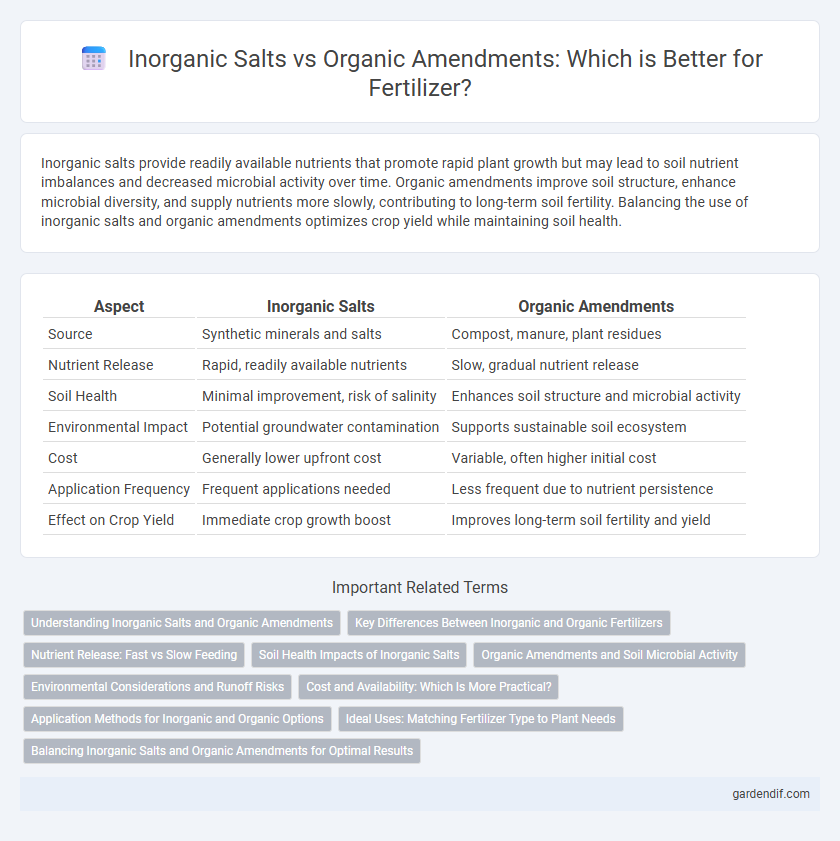
Inorganic salts vs Organic amendments Illustration
Inorganic salts provide readily available nutrients that promote rapid plant growth but may lead to soil nutrient imbalances and decreased microbial activity over time. Organic amendments improve soil structure, enhance microbial diversity, and supply nutrients more slowly, contributing to long-term soil fertility. Balancing the use of inorganic salts and organic amendments optimizes crop yield while maintaining soil health.
Table of Comparison
| Aspect | Inorganic Salts | Organic Amendments |
|---|---|---|
| Source | Synthetic minerals and salts | Compost, manure, plant residues |
| Nutrient Release | Rapid, readily available nutrients | Slow, gradual nutrient release |
| Soil Health | Minimal improvement, risk of salinity | Enhances soil structure and microbial activity |
| Environmental Impact | Potential groundwater contamination | Supports sustainable soil ecosystem |
| Cost | Generally lower upfront cost | Variable, often higher initial cost |
| Application Frequency | Frequent applications needed | Less frequent due to nutrient persistence |
| Effect on Crop Yield | Immediate crop growth boost | Improves long-term soil fertility and yield |
Understanding Inorganic Salts and Organic Amendments
Inorganic salts, commonly used as fertilizers, provide plants with readily available nutrients such as nitrogen, phosphorus, and potassium, promoting rapid growth and immediate nutrient uptake. Organic amendments, derived from natural sources like compost and manure, enhance soil structure, increase microbial activity, and slowly release nutrients over time, improving long-term soil fertility. Understanding the balance between inorganic salts for quick nutrient availability and organic amendments for sustainable soil health is crucial for optimized crop production and environmental sustainability.
Key Differences Between Inorganic and Organic Fertilizers
Inorganic fertilizers consist of synthetic chemical compounds such as ammonium nitrate and superphosphates, providing immediate nutrient availability but with potential environmental risks like leaching and soil degradation. Organic amendments, derived from natural sources like compost, manure, and bone meal, improve soil structure and microbial activity while releasing nutrients more slowly and sustainably. Key differences include nutrient composition stability, release rate, environmental impact, and long-term effects on soil health and fertility.
Nutrient Release: Fast vs Slow Feeding
Inorganic salts provide fast nutrient release, delivering essential elements like nitrogen, phosphorus, and potassium rapidly for immediate plant uptake. Organic amendments break down slowly through microbial activity, offering a gradual, sustained nutrient supply that improves soil structure and increases microbial diversity. The choice between fast feeding inorganic salts and slow-release organic amendments impacts fertilization efficiency, crop growth timing, and long-term soil health.
Soil Health Impacts of Inorganic Salts
Inorganic salts, commonly used as fertilizers, provide essential nutrients like nitrogen, phosphorus, and potassium but can lead to soil acidification and salinity, impairing microbial diversity and soil structure. Prolonged use of inorganic salts often results in nutrient imbalances and reduced organic matter content, which diminishes soil fertility and water retention capacity. These impacts emphasize the need for integrated soil management practices to sustain long-term soil health and productivity.
Organic Amendments and Soil Microbial Activity
Organic amendments such as compost, manure, and cover crops significantly enhance soil microbial activity by providing essential nutrients and carbon sources that stimulate microbial biomass and diversity. Increased microbial activity improves nutrient cycling, soil structure, and overall fertility, promoting sustainable crop growth. Unlike inorganic salts, organic amendments foster long-term soil health through the enrichment of beneficial microorganisms and enzymatic processes.
Environmental Considerations and Runoff Risks
Inorganic salts such as ammonium nitrate and potassium chloride provide readily available nutrients but pose significant environmental risks due to high solubility, which increases runoff potential and contamination of water bodies. Organic amendments like compost and manure release nutrients more slowly, enhancing soil structure and microbial activity, thus reducing nutrient leaching and runoff risks. Managing application rates and timing for both fertilizer types is critical to minimizing eutrophication and preserving aquatic ecosystems.
Cost and Availability: Which Is More Practical?
Inorganic salts offer a cost-effective solution with high nutrient concentration, making them widely available for large-scale agricultural use. Organic amendments, though often more expensive and less concentrated, improve soil structure and microbial activity, providing long-term sustainability. Practicality depends on immediate nutrient needs and budget constraints, where inorganic salts favor affordability and accessibility, while organic amendments suit long-term soil health investment.
Application Methods for Inorganic and Organic Options
Inorganic salts are typically applied through fertigation, soil dressing, or foliar sprays, allowing precise nutrient delivery and rapid uptake by plants. Organic amendments require incorporation into the soil via tilling, mulching, or composting to enhance soil structure and gradually release nutrients. Combining these application methods optimizes nutrient availability and supports sustainable crop growth.
Ideal Uses: Matching Fertilizer Type to Plant Needs
Inorganic salts provide essential nutrients like nitrogen, phosphorus, and potassium in readily available forms that support immediate plant uptake and rapid growth, making them ideal for correcting specific nutrient deficiencies in high-demand crops. Organic amendments, such as compost and manure, improve soil structure, enhance microbial activity, and release nutrients slowly, which benefits long-term soil health and sustains plants requiring steady nutrient supply. Selecting the appropriate fertilizer type depends on crop nutrient requirements, soil condition, and growth stage to optimize plant health and yield.
Balancing Inorganic Salts and Organic Amendments for Optimal Results
Balancing inorganic salts and organic amendments is crucial for optimizing soil fertility and crop yield. Inorganic salts provide immediate nutrient availability, such as nitrogen, phosphorus, and potassium, while organic amendments enhance soil structure, microbial activity, and long-term nutrient retention. Integrating both ensures efficient nutrient cycling, reduces salt buildup, and improves soil health for sustainable agricultural productivity.
Inorganic salts vs Organic amendments Infographic

 gardendif.com
gardendif.com